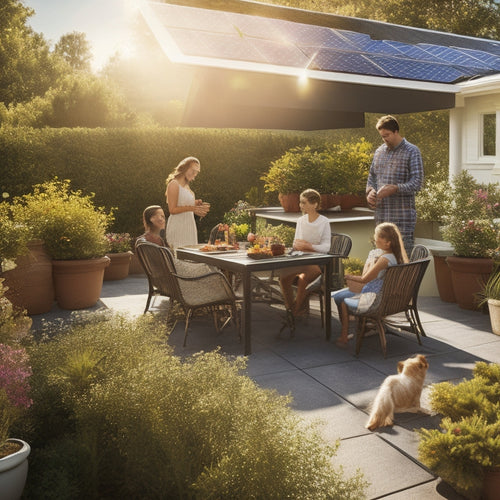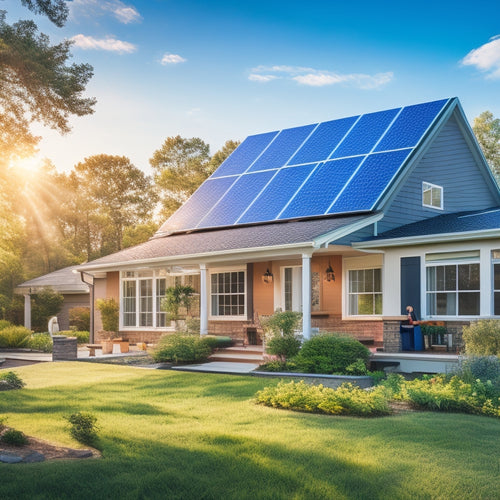
What Are the Best Commercial Solar Inverters Online?
Share
When selecting the best commercial solar inverter for your project, you'll want to prioritize top brands like SMA, Fronius, and Schneider Electric, which offer a combination of innovation, quality, and customer satisfaction. These brands emphasize high efficiency, peak shaving, and thermal management for excellent performance. Look for key features like maximum power point tracking, grid support, monitoring capabilities, and durability with surge protection. Additionally, take into account the type of inverter, such as string or central, and its adaptability to your specific project needs. Now, discover the specific factors that'll contribute to the success of your commercial solar project.
Key Takeaways
• Top brands like SMA, Fronius, and Schneider Electric offer high-quality commercial solar inverters with innovative features and exceptional customer support.
• Look for inverters with high efficiency, peak shaving, and thermal management for optimal performance and energy generation.
• Consider string inverters for flexibility and modularity or central inverters for large-scale projects and cost-effectiveness.
• Grid-tie inverters enable selling excess energy back to utility companies and offer commercial scalability for large-scale applications.
• Remote troubleshooting capabilities and automated alerts are essential for minimizing downtime and improving operational continuity.
Top Brands for Commercial Inverters
When selecting a commercial solar inverter, you're likely to come across several top brands that have established themselves as industry leaders, including SMA, Fronius, and Schneider Electric. These brands have built a strong reputation in the market, thanks to their commitment to innovation, quality, and customer satisfaction.
As you navigate the market trends, you'll notice that these industry leaders consistently rank high in customer reviews and ratings. Their brand reputation is built on a foundation of reliability, efficiency, and durability.
When evaluating these top brands, consider their customer support services. Look for brands that offer extensive warranties, dedicated customer service teams, and abundant resources for troubleshooting and maintenance. A brand that stands behind its products and provides exceptional customer support is more likely to guarantee a smooth and hassle-free installation and operation of your commercial solar inverter.
Inverter Efficiency and Performance
As you evaluate the performance of a commercial solar inverter, efficiency emerges as a critical factor, directly impacting the amount of usable energy your system generates. A high-efficiency inverter guarantees that more of the sun's energy is converted into usable power, reducing energy losses and increasing overall system performance.
| Inverter Efficiency | Peak Shaving | Thermal Management |
|---|---|---|
| 98.5% | Optimizes energy output during peak hours | Active cooling system |
| 97.5% | Reduces energy consumption during off-peak hours | Passive cooling system |
| 96.5% | Real-time monitoring for peak shaving | Hybrid cooling system |
When selecting a commercial solar inverter, it's important to take into account the inverter's efficiency, peak shaving capabilities, and thermal management features. Peak shaving, for instance, allows you to optimize energy output during peak hours, reducing energy consumption during off-peak hours. Thermal management, on the other hand, ensures that the inverter operates within a safe temperature range, preventing overheating and increasing the system's lifespan. By prioritizing these factors, you can maximize the performance and efficiency of your commercial solar inverter, unleashing the full potential of your solar energy system.
Key Features to Look For
You'll want to focus on several key features when selecting a commercial solar inverter, including maximum power point tracking, grid support, and monitoring and control capabilities. Maximum power point tracking (MPPT) guarantees your system operates at peak levels, while grid support features enable your inverter to interact with the grid efficiently. Monitoring and control capabilities allow you to track performance, identify issues, and make adjustments remotely.
Inverter durability is also vital, as it directly impacts your system's lifespan and overall performance. Look for inverters with sturdy designs, high-quality components, and protective features like surge protection and overvoltage protection.
System flexibility is another key aspect to take into account, as it enables you to adapt to changing energy demands and expand your system as needed. A flexible system allows you to add or remove components, reconfigure your setup, and integrate with other renewable energy sources.
Comparing String and Central Inverters
When selecting a commercial solar inverter, you'll likely encounter two primary options: string inverters and central inverters.
You'll want to understand the benefits of each to make an informed decision for your solar array.
Let's break down the advantages of string and central inverters to determine which one is right for your project.
String Inverter Benefits
String inverters offer a higher degree of flexibility and modularity compared to central inverters, allowing you to tailor your solar array's design to specific site conditions and energy output requirements. This flexibility is essential in maximizing energy harvest and reducing costs. With string inverters, you can design a system that accommodates different panel orientations, tilts, and shading patterns, ensuring the best energy production.
| Benefit | Description |
|---|---|
| System Flexibility | Allows for customization to specific site conditions and energy output requirements |
| Reduced Downtime | Individual string inverters can operate independently, minimizing system downtime in case of maintenance or faults |
| Improved Monitoring | Enables real-time monitoring of individual strings, allowing for quick identification and resolution of issues |
| Simplified Maintenance | Easier maintenance and replacement of individual string inverters, reducing overall system downtime |
Central Inverter Advantages
Central inverters, deployed in large-scale solar farms and utility projects, offer a more cost-effective solution per megawatt of installed capacity compared to string inverters. As you compare string and central inverters, you'll find that central inverters have several advantages.
For one, they provide High reliability due to their simplified design, which reduces the risk of component failure. Additionally, central inverters offer Space efficiency, as they can be designed to accommodate larger capacities in a smaller footprint. This makes them ideal for large-scale solar farms where space is limited.
Some other key benefits of central inverters include:
-
Scalability: Central inverters can be easily scaled up or down to accommodate changing energy demands.
-
Easy maintenance: With fewer components and a more streamlined design, central inverters are easier to maintain and repair.
-
Improved monitoring and control: Central inverters often come equipped with advanced monitoring and control systems, allowing for real-time tracking and optimization of energy production.
Grid-Tie Inverters for Commercial Use
Grid-tie inverters, designed to synchronize with the grid's frequency and voltage, efficiently convert your commercial solar array's DC power into AC electricity, feeding it seamlessly into the grid. This synchronization enables you to sell excess energy back to the utility company, offsetting your energy costs.
As you scale up your commercial solar installation, you'll appreciate the commercial scalability of grid-tie inverters. They can be easily paralleled to accommodate growing energy demands, making them an ideal choice for large-scale commercial applications.
Additionally, many modern grid-tie inverters come with built-in energy storage capabilities, allowing you to store excess energy for later use. This feature is particularly useful during periods of low energy demand or when the grid is experiencing high demand.
With grid-tie inverters, you can optimize your energy production, reduce your reliance on the grid, and increase your energy independence. By choosing the right grid-tie inverter for your commercial solar installation, you can maximize your return on investment and achieve true energy liberation.
Monitoring and Maintenance Options
You can optimize the performance of your commercial solar array by utilizing advanced monitoring and maintenance options that provide real-time insights into system performance, energy production, and potential issues. With the right tools, you can identify and address issues promptly, ensuring your system operates at maximum efficiency. This leads to increased energy production, reduced downtime, and lower maintenance costs.
Some of the advanced monitoring and maintenance options available include:
-
Data Analytics: Gain valuable insights into your system's performance with advanced data analytics. This enables you to identify trends, optimize energy production, and make data-driven decisions.
-
Remote Troubleshooting: Remote troubleshooting capabilities allow you to identify and resolve issues quickly, reducing the need for on-site visits and minimizing downtime.
-
Automated Alerts: Receive automated alerts and notifications when issues arise, ensuring prompt attention and minimizing potential losses.
Price and Warranty Considerations
When evaluating commercial solar inverter options, it's important to take into account the upfront cost and warranty offered, as these factors greatly influence your return on investment and long-term savings. As you compare prices, consider not only the initial purchase cost but also ongoing expenses, such as insurance costs, maintenance, and potential repair fees. Be sure to factor in any discount options, like bulk purchasing or package deals, that can help reduce your overall expenditure.
A thorough warranty is essential to minimize downtime and reduce repair costs. Look for inverters with a minimum 10-year warranty, and consider options with extended warranty periods or dedicated support teams. Additionally, investigate the manufacturer's reputation for honoring warranty claims and providing timely support.
Frequently Asked Questions
Can I Use Residential Inverters for Small Commercial Solar Systems?
When sizing a small commercial solar system, you'll need to take into account whether residential inverters can meet your needs, evaluating factors like cost comparison and system sizing to guarantee peak performance and efficiency.
How Do I Ensure Inverter Compatibility With My Solar Panel Array?
Did you know that 70% of solar installations experience inverter compatibility issues? To guarantee a seamless match, you'll need to take into account your array configuration and system monitoring capabilities when selecting an inverter for your commercial solar system.
Can I Install Commercial Inverters in Outdoor Environments?
When installing commercial inverters outdoors, you'll need to make sure they're weather-resistant and can withstand environmental factors like temperature extremes, humidity, and physical stress, so choose models with IP65 or higher ratings for best performance.
Are Commercial Solar Inverters Compatible With Energy Storage Systems?
You'll be pleased to know that commercial solar inverters are indeed compatible with energy storage systems, enabling seamless energy integration and allowing for precise system sizing to optimize your renewable energy setup.
Do Commercial Inverters Require Professional Installation and Maintenance?
You'll typically need professional installation and maintenance for commercial inverters, adhering to industry standards, as improper setup can increase installation costs and compromise system efficiency, so it's important to work with certified professionals.
Related Posts
-

Long-Term Cost Savings With Solar Panels
Investing in solar panels offers substantial long-term savings on energy costs. You'll benefit from federal tax credi...
-

Eco-Friendly Home Design Ideas for Beginners
If you're starting your eco-friendly home design expedition, focus on sustainable materials like recycled wood or rec...
-

Solar Energy Grants and Incentives for Homeowners
Maneuvering solar energy grants and incentives is essential for reducing your installation costs. You can benefit fro...


